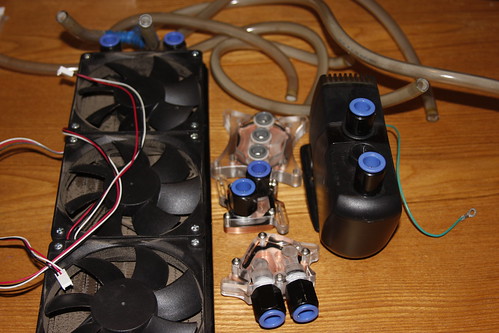08.29
Up until a few weeks ago I had a water cooled pc at home. Given the relatively exotic nature of water cooling I thought it might be interesting to consider after a year has passed I thought it might be interesting to do a little retrospective on the whole thing.
I started out this adventure with a cobbled together machine with roughly these parts:
| CPU | Core2 e6600 CPU |
| GPU | Radeon 3870 GPU |
| RAM | 4 Gigs Crucial DDR 2 |
The CPU clocked in at an anemic 2.66ghz. I didn’t feel like spending the money to jump up to an i7 rig at the time. With the large CPU cooler I had purchased I achieved a pretty reasonable overclock but between the CPU cooler, case fan, graphics card fan, and the power supply fan the system was annoyingly loud.
I picked up an asetek waterchill water cooling kit for about $120 shipped. As far as I can tell it was the best deal around, at the time. I priced out the individual components to build a custom kit and the asetek was far, far ahead. The loop included the CPU, north-bridge, and the GPU with a large radiator and three cooling fans. Setup was relatively straightforward, You measure and cut the tubing, assemble the pc and attach the loop, then test it with the power supply jumpered and disconnected from the motherboard. If it runs overnight with no leaks you can take the never wracking step of testing it with the machine connected and powered up.
The main components, minus wiring and mounting hardware are show below:

The performance increase was pretty much as expected. I got a very stable overclock of about 1 GHz without over-volting. The biggest win, was the overall decrease in noise. For surfing/video I could easily crank down the pump and fan speed and the system would run whisper quiet. Under full load, it was noisy, but the system would run under maximum CPU/GPU load and just barely crack 40 ℃. Typically when the system was under that kind of load I had the sound turned up so high the fans weren’t even noticeable.
Alas, the it didn’t have the long life it should have. After running the machine for about a year with not a hint of trouble I needed to fill up the water level. I never appropriately mounted the radiator to the case and ended up dripping a little bit of water from the CPU block onto the PCI-E port on the motherboard, toasting both the graphics card and the PCI-E port. Some quick mental math gave the sad numbers that repairing the system wouldn’t be worth the overhead, and so I’m parting the system out and saving towards an i7 build in the in near future.
I have to say that, if I was building a machine with up to date hardware I wouldn’t bother with water cooling. Yes, it’s possible to get a significant performance boost, but unless the machine is loaded with a RAID array of SSD’s most applications and games are going to bottleneck at the hard-drive, GPU, or network. When you consider the risk of totally frying the entire system, and combine that with the difficulty of replacing and testing for failure individual components in the loop, water-cooling isn’t worth the trouble. Intel Sandybridge chips have been reported to easily overclock to 4GHz and beyond on air cooling and it seems that PC hardware has outraced performance demand for now. Still, they say the measure of any endeavor is “Would you make the same choice again, if you had the chance” In this case I’d have to say a definite yes. If you’re looking to keep an aging system limping along, or trying to cut the noise level of your gaming rig, water cooling might be the way to go.
No Comment.
Add Your Comment